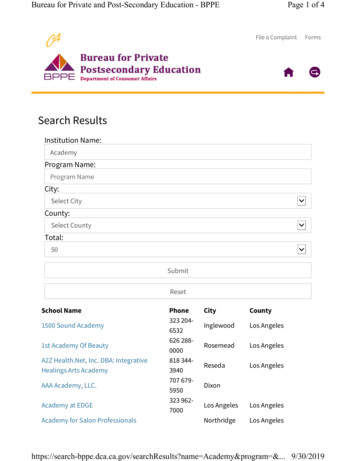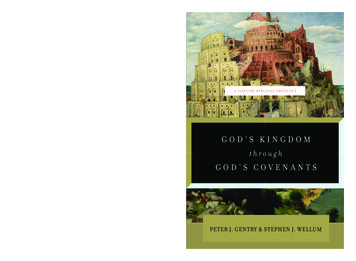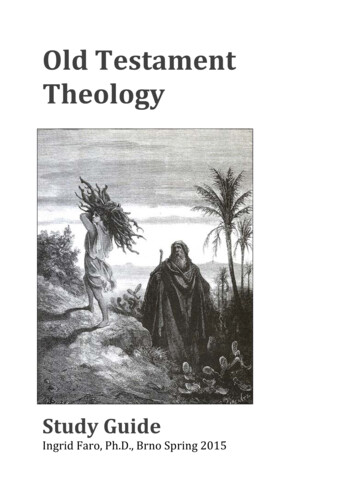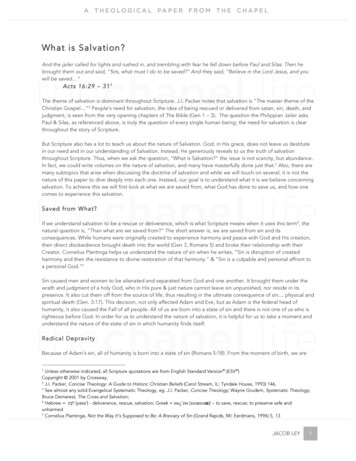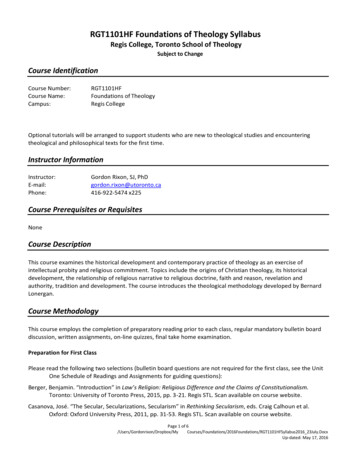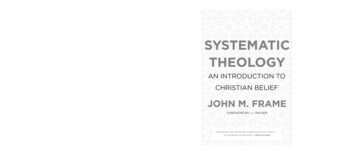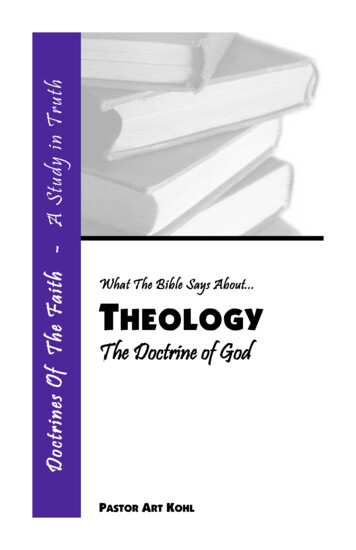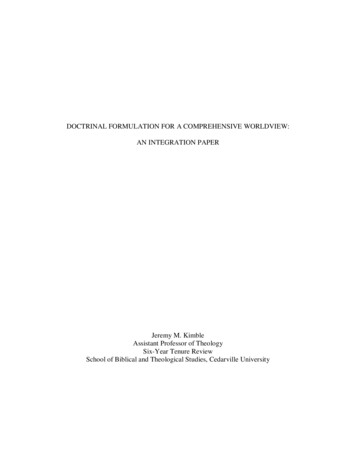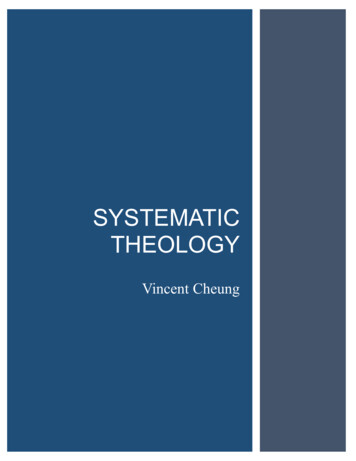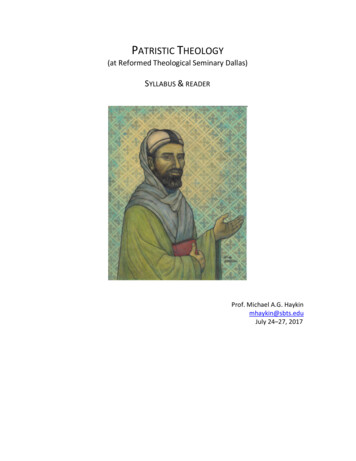
Transcription
PATRISTIC THEOLOGY(at Reformed Theological Seminary Dallas)SYLLABUS & READERProf. Michael A.G. Haykinmhaykin@sbts.eduJuly 24–27, 2017
Page 2PATRISTIC THEOLOGYMichael A. G. Haykinmhaykin@sbts.edu“To do theology withouthistory is to study cutflowers, not living plants”(Michael Blecker)“There can be no healthytheology without a solidgrounding in the Fathers”(Edward T. Oakes)“Every Christian ought tobe a good historian”(Caleb Evans)I. COURSE DESCRIPTIONThis course traces the major doctrinal andecclesiological developments in the Ancient Churchwithin the context of her times—from the Letter toDiognetus through to the Trinitarian and Christologicaldebates of the 4th and 5th centuries and the Irish Missionof Patrick. Special attention is given to the developmentof the doctrine of the Trinity, the theology of cultureand mission, and the interface of Patristic theology andpiety.II. COURSE OBJECTIVESThe objective of the course is basically threefold. First,to provide the student with a basic understanding ofPatristic theology. Second, to foster within the studentan awareness of and appreciation for the theologicalachievements of the Ancient Church. Third and final, tofurnish the student with models for imitation in his/herChristian life (see Hebrews 11:1–12:3; 13:7).July 24–27, 2017Reformed TheologicalSeminary DallasIII. COURSE TEXTS1. Mark DelCogliano, Andrew Radde-Gallwitz, andLewis Ayres, Works on the Spirit: Athanasius’sLetters to Serapion on the Holy Spirit and Didymus’sOn the Holy Spirit (Popular Patristics Series, no.43;Yonkers, New York: St. Vladimir’s Seminary Press,2011).2. Augustine, Confessions, trans. R.S. Pine-Coffin(Harmondsworth, Middlesex: Penguin, 1961).3. Basil of Caesarea, On the Holy Spirit, trans. StephenM. Hildebrand (Popular Patristics Series, no.42;Crestwood, NY: St. Vladimir’s Seminary Press, 2011).4. Tim Dowley, ed., Introduction to the History ofChristianity (2nd ed.; Minneapolis, MN: FortressPress, 2013).5. Gregory of Nyssa, The Life of Saint Macrina (2001ed.; repr. Eugene, OR: Wipf & Stock, 2005).
Page 36. Michael A.G. Haykin,RediscoveringtheChurch Fathers: WhoThey Were and HowThey Shaped theChurch (Wheaton,IL: Crossway, 2011).
Page 4IV. COURSE REQUIREMENTS1. This course will meet at the following times during the week of July 24-27, 2017, withappropriate breaks: Monday through Thursday, 9am–5:30pm.2. 20% of the final mark is based on a critical book review of Haykin, Rediscovering the ChurchFathers. This book review should be no more than 2,000 words and is due August 15, 2017.It should include a summary of the book (about 1200 words) as well as a critical evaluationof the book’s achievement of its goals (about 800 words). The student should also consultpublished book reviews of Haykin. References to these critical book reviews need to bemade by way of footnotes. Marks will be deducted for numerous grammar and spellingerrors. This assignment should be mailed as a hard copy to the professor at The SouthernBaptist Theological Seminary, 2825 Lexington Avenue, Louisville, KY 40280, and bepostmarked August 15, 2017.3. There will be written post-course assignments for many of the lectures. These assignmentswill usually consist of brief answers to questions based on primary and secondary sources.Assignments must be in sentence form and a type-written format. Marks will be deductedfor numerous grammar and spelling errors. These written assignments constitute 80% ofthe final mark. A number of these assignments require texts not found in the textbooks.These texts are assembled in the Reader at the back of this Syllabus or can be found online.All of these assignments are due August 31, 2017 and should be mailed as a hard copy tothe professor at The Southern Baptist Theological Seminary, 2825 Lexington Avenue,Louisville, KY 40280, and be postmarked August 31, 2017.4. Papers submitted late without advance permission will receive at best a grade of D.Extensions will be granted in the case of such things as family or personal illness.
Page 5V. COURSE OUTLINE AND HOMEWORK ASSIGNMENTSMONDAY, JULY 24, 2017Lecture 1: Introduction to the course & the significance of Patristic theologyLectures 2–3: Roman Hellenism: the context of Patristic theologyLectures 4–5: Patristic apologetic thought: The Letter to Diognetus1. The author of The Letter to Diognetus (Reader, text 4) is unknown. Why has the authorspecifically written this letter according to The Letter to Diognetus 1?2. What opinion is expressed in The Letter to Diognetus 2 about the Greek and Romanreligions? Why? What do you think of the author’s evangelistic strategy at this point andwhy?3. The Letter to Diognetus 2: Why are Christians hated?4. How does the author of The Letter to Diognetus 3–4 view Judaism? Does the NewTestament view Judaism in the same way? Give specific references in the New Testamentto support your answer.5. According to The Letter to Diognetus 5–6:a. What distinguished Christians from the society in which they lived? Give some specificexamples.b. How does the author describe the reaction of the Greeks and Romans to the Christiancommunity?c. How do Christians in turn respond to the way that they are treated by Graeco-Romansociety?6. According to The Letter to Diognetus 7–8:a. How does one come to obtain true knowledge about the nature of God?b. How is Christ described in this passage?c. Who are the “philosophers” that the author is referring to in The Epistle to Diognetus 8?
Page 6d. The Letter to Diognetus 7: What does the author see as “the evidences of his [i.e. God’s]presence”?7. What answer does the author of The Letter to Diognetus give to the question raised inchapter 1 about why Christianity has entered into our world now and not formerly? ReadThe Letter to Diognetus 8–9.8. The Letter to Diognetus 9: Discuss the author’s view of the atonement.9. The Letter to Diognetus 10: What answer does the author give to the question raised inchapter 1 about the affection that Christians have for one another?10. The Letter to Diognetus 11–12: After reading the final two chapters of this work, whatwould you say is its relationship to the first ten chapters?11. Would The Letter to Diognetus have been a convincing apology for Christianity in thesecond century A.D.? Why or why not? Be specific in your answer.Lecture 6: Gnostic thought1. Summarize in a couple of pages Edwin M. Yamauchi, “The Gnostics” in Dowley, ed., Historyof Christianity, 68–71 and H. Dermot McDonald, “Marcion” in Dowley, ed., History ofChristianity, 50.2. Read the selections from The Gospel of Thomas (Reader, text 5a) and answer the followingquestions:a. What similarities do you see to the four canonical gospels? What differences?b. The Gospel of Thomas, Saying 14: What is the meaning of this saying?c. The Gospel of Thomas, Saying 50: Any ideas as to the meaning of this saying?d. The Gospel of Thomas, Saying 52: How does the Jesus of the Gospel of Thomas view theOld Testament?e. The Gospel of Thomas, Saying 114: What is being said in this saying? What does itmean?3. Read the selections from The Gospel of Philip (Reader, text 5b) and answer the followingquestions:
Page 7a. The Gospel of Philip, Saying 7: What is being said about prayer in this text? CompareSaying 115.b. The Gospel of Philip, Saying 23: Summarize in a sentence or so the worldview thatinforms this saying.c. The Gospel of Philip, Sayings 24–25: How does this text interpret Paul’s statement In 1Corinthians 15:50? And how does this passage confirm the worldview informing Saying23?d. The Gospel of Philip, Saying 55: Explain the meaning of this saying.e. The Gospel of Philip, Sayings 63, 98, and 101: Why is chrismation superior to baptism?What is being implied about the baptism given in orthodox churches?f. The Gospel of Philip, Sayings 76 and 86: Why did Christ come into the world?
Page 8TUESDAY, JULY 25, 2017Lectures 7–8: Irenaeus and his theologyNote: Unless otherwise specified, all of the texts can be found on “Irenaeus, Against heresies” athttp://www.textexcavation.com/irenaeusah.html.1. Irenaeus, Against Heresies 1.10.1–2, trans. Alexander Roberts and W.H. Rambaut in A.Cleveland Coxe, arr., The Apostolic Fathers with Justin Martyr and Irenaeus (Ante-NiceneFathers, vol.1; repr. New York: Charles Scribner’s Sons, 1903), 330–331:a. What does the Church believe regarding God the Father?b. God the Son?c. And the Holy Spirit?2. Irenaeus, Against Heresies 1.22.1, trans. Roberts and Rambaut in Coxe, arr., Justin Martyrand Irenaeus, 347:a. What roles are assigned to the Holy Spirit?b. What biblical proof does Irenaeus give to support his view in this regard?3. Irenaeus, Against Heresies 2.28.2–3; 3.1.1, trans. Roberts and Rambaut in Coxe, arr., JustinMartyr and Irenaeus, 399, 414:a. What role is assigned to the Spirit in these two texts?b. What is the significance of this fact with regard to the nature of Scripture?c. If Scripture is perfect, what does this say about its author?4. Irenaeus, Against Heresies 3.2.1–2, trans. Roberts and Rambaut in Coxe, arr., Justin Martyrand Irenaeus, 415:a. How do the Gnostics respond to the use of the Scriptures by orthodox believers? Why?b. How do they view apostolic traditions? Why?5. Irenaeus, Against Heresies 3.3.1–4, trans. Roberts and Rambaut in Coxe, arr., Justin Martyrand Irenaeus, 415–416:a. How does Irenaeus respond to the Gnostic rejection of apostolic tradition?b. How does Irenaeus view the Church at Rome? What part does this view of the church atRome play in his response to the Gnostic rejection of tradition?c. What is the significance of the fact that Irenaeus sat under Polycarp’s instruction?
Page 96. Irenaeus, Against Heresies 4.20.1, trans. Rambaut in Coxe, arr., Justin Martyr and Irenaeus,487–488:a. What is the significance of the description of the Son and the Holy Spirit as the “hands”of God?b. How do you personally react to this description?7. Irenaeus, Against Heresies 5.9.2–4, trans. Rambaut in Coxe, arr., Justin Martyr and Irenaeus,535:a. How does Irenaeus interpret the assertion of Paul that “flesh and blood cannot inheritthe kingdom of God” (1 Corinthians 15:50)?b. What are some of the implications of being indwelt by the Spirit?8. Irenaeus, Against Heresies 5.8.1, trans. Rambaut in Coxe, arr., Justin Martyr and Irenaeus,533:a. What is the significance of the earnest of the Spirit according to this passage?b. Judging from the tone of this text, what do you suppose were Irenaeus’ feeling when hewrote it?9. Irenaeus, Against Heresies 5.12.4, trans. Rambaut in Coxe, arr., Justin Martyr and Irenaeus,538: What does Irenaeus mean when he says “the final result of the work of the Spirit is thesalvation of the flesh”?10. Irenaeus, Against Heresies 5.12.1–2, trans. Rambaut in Coxe, arr., Justin Martyr andIrenaeus, 537–538:a. What are the differences between “the breath of life” and “the vivifying Spirit”?b. What is the ontological significance of describing the Spirit as “eternal”?
Page 10Lectures 9–10: Christian thought in North Africa: 1. TertullianNote: Unless otherwise specified, all of the texts can be found on “The Tertullian Project” atwww.tertullian.org.1. Read The Acts of the Scillitan Martyrs (Reader, text 3). What do you learn about NorthAfrican Christianity from this text?2. Read and summarize Everett Ferguson, “Tertullian” in Dowley, ed., History of rst.htm).3. Tertullian, To His Wife 2.8 (Reader, text 6): What is Christian marriage?4. Tertullian, Apology 37–39, trans. Alexander Souter:a. How do Christian differ from their fellow Romans who are pagans?b. What happens when Christian meet together for worship?c. What mark of the church does Tertullian emphasize?5. Tertullian, On the Resurrection of the Flesh 63.7–9, trans. Ernest Evans: According to thispassage, why has the “New Prophecy” come into existence?6. Tertullian, On the Soul 9.1–4, trans. Peter Holmes: For what is Tertullian arguing in thispassage? How does he attempt to demonstrate the truth of his position?7. Tertullian, On the Soul 55.5, trans. Holmes: According to this text, what does the Holy Spiritcounsel believers to do?8. Tertullian, Flight in Time of Persecution 9.4 and 14.3, trans. S. Thelwall:a. What does the Spirit lead believers to do?b. What proof does Tertullian offer for his position in Flight in Time of Persecution 9.4?9. Tertullian, On Monogamy 1–2, trans. S. Thelwall:a. Who are the heretics that Tertullian is discussing in this text? Who do you suppose the“Sensualists” (psychichi) are?b. Of what does Tertullian accuse the “Sensualists” in On Monogamy 1?c. What, according to On Monogamy 2, is the view of the “Sensualists” about the Montanistposition on marriage?d. How does Tertullian reply to this view of the “Sensualists” (On Monogamy 2)?
Page 1110. Tertullian, On Monogamy 14, trans. S. Thelwall: What does Tertullian argue was Paul’s viewof remarriage?11. Tertullian, On Monogamy 14, trans. S. Thelwall: What has the Paraclete, through the “NewProphecy,” done to Paul’s “indulgence” with regard to remarriage after the death of one’sspouse?12. Tertullian, On the Veiling of Virgins 1, trans. S. Thelwall:a. Why was the Paraclete/Holy Spirit sent according to this passage?b. What are the various dispensations which Tertullian delineates and how are theydistinguished?c. On the Veiling of Virgins 1: According to this passage, what does the Spirit require in thisdispensation?13. Tertullian, On Purity 1.20–21, trans. Gösta Claesson: What errors has Tertullian left behindwhen he became a Montanist?14. Tertullian, On Purity 21, trans. Gösta Claesson:a. What does the Spirit teach?b. How do the non-Montanist Christians respond to this teaching about the forgiveness of“mortal sins”?c. What is Tertullian’s reply to the statement that “the Church has the power to forgivesins”?d. How does he seek to show that this prophetic word actually comes from the Holy Spirit?e. Why does Tertullian launch into a discussion of Matthew 16:18–19?f. How does Tertullian interpret this passage in Matthew, particularly with regard as to whohas the power to forgive sins?g. What is the “Church of the Spirit”?15. Tertullian, Against Praxeas 8, 13, 30, trans. Ernest Evans, Tertullian’s Treatise AgainstPraxeas (London: S.P.C.K., 1948), 139–140, 147–148, 178–179: What do these sourcesreveal about Tertullian’s view of the Spirit?16. Suggest reasons as to why Tertullian embraced the “New Prophecy.”
Page 12Lectures 11–12: Christian thought in North Africa: 2. Cyprian of Carthage1. Summarize David F. Wright, “Cyprian of Carthage” in Dowley, ed., History of Christianity, 88.2. Cyprian, To Donatus 2–8, 14–16 (Reader, text 8):a. Detail the theology of conversion in To Donatus 3–4.b. What is meant by the phrase “the laver of the saving water” and the “water ofregeneration”? Are these biblical expressions?c. To Donatus 7–8: Why are gladiatorial fights and the Roman theatre not places to befrequented by Christians?d. What does the Spirit do according to To Donatus 4–5 and 14–15?3. What does the physical structure and design of the baptistery of the Basilica of St. Vitalis inTunisia (depicted in Dowley, ed., History of Christianity, 85) tell you about early Christianthinking about baptism?
Page 13WEDNESDAY, JULY 26, 2017Lecture 13: The Constantinian revolution1. Read “Medieval Sourcebook: Diocletian: Edicts Against The urce/persec1.asp). How did the Roman state seek todestroy Christianity?2. Eusebius of Caesarea was an eyewitness to the sufferings and martyrdoms of believersduring the Diocletianic persecution. Read two excerpts from his Church History (Historiaecclesiastica) 8.8–9; 8.12.10–11 How would you explain the ferocity of the persecution and the malevolence behind it?3. Read Richard A. Todd, “Constantine and the Christian Empire” in Dowley, ed., History ofChristianity, 104–109 and answer the following questions:a.b.c.d.What were Constantine’s religious beliefs?How did Constantine treat the Christian Church? Why?What were the results of Constantine’s attitude to Christianity?Outline some of the specific instances in which Constantine intervened in the life of theChurch.4. Summarize Michael A. Smith, “Eusebius: ‘Father of Church History’ ” in Dowley, ed., Historyof Christianity, 75.5. What purpose did “the one empire of Rome” serve according to the following text ofEusebius of Caesarea, Demonstration of the Gospel 3.7.32, trans. W.J. Ferrar, Eusebius: TheProof of the Gospel (1920 ed.; repr. Grand Rapids, MI: Baker Book House, 1981), I, 161:
Page 14“All must wonder if they consider and reflect, that it was not by mere human accident thatthe greater part of the nations of the world were never before under the one Empire ofRome, but only from the time of Jesus. For his wonderful sojourn among men synchronizedwith Rome’s attainment of the acme of power.Since that day the Jewish people havebecome subject to the Romans, the Syrians likewise, the Cappadocians and theMacedonians, the Bithynians and Greeks, and in a word all other nations who are underRoman rule. And no one could deny that the synchronizing of this with the beginning of theteaching about our Saviour is of God’s arrangement, if he considered the difficulty of thedisciples’ taking their journey, had the nations been at variance one with another and notmixing together because of varieties of government. But when these were abolished theycould accomplish their projects quite fearlessly and safely, since the supreme God hadsmoothed the way before them and subdued the spirit of the more superstitious citizensunder the fear of a strong central government.”6. Read the two statements by Constantine in the Reader, texts 9a & 9b. What is he sayingabout his relationship to God and his personal religious beliefs?7. Read some of the laws passed by Constantine with regard to the Church: -laws2.html). Do these documents tell youanything about Constantine’s religious convictions? If so, what?8. Eusebius of Caesarea, Oration in Honour of at-constantine.asp):1–3(onlineata. What is the major theme of these sections of Eusebius’ speech in honor of Constantine’sthirtieth anniversary?b. What examples does Eusebius give to illustrate this theme?9. Read “Socrates Scholasticus: The Murder of Hypatia (late 4th patia.html): What is the significance of themurder of Hypatia? Be sure you know who Hypatia is. For the latter, see “Hypatia:Mathematician and Astronomer” ture 14: Early monastic thought1. Draw up a 400-word summary of Michael A. Smith, “Ascetics and Monks: The rise ofChristian monasticism” in Dowley, ed., History of Christianity, 169–173 with specialreference to the early monastic leaders in the eastern Mediterranean.
Page 15Lectures 15–16: Arian theology, Athanasius’ thought, and Nicene Trinitarianism1. Draw up a summary of David F. Wright, “Councils and Creeds: Defining and defending thefaith” in Dowley, ed., History of Christianity, 117–124.2. com/index.php/urkunde-1/):Nicomedia,318a. What has Alexander of Alexandria (d.328) taught regarding the Son?b. What does Arius believe about the Son?3. Look at the map that locates the early support for Arius, “Arius Map”(http://www.fourthcentury.com/arius-map/): which geographical regions most stronglysupported Arianism in the 320s and 330s?4. Read The Nicene Creed (Reader, text 10):a. How does this creedal statement affirm the full deity of Christ?b. Is the Christology of this Creed biblical? Explain.5. Summarize Everett Ferguson, “Athanasius” in Dowley, ed., History of Christianity, 121.6. Athanasius, Letter to Serapion 1.3–14 (trans. Mark DelCogliano, Andrew Radde-Gallwitz, andLewis Ayres, Works on the Spirit: Athanasius’s Letters to Serapion on the Holy Spirit andDidymus’s On the Holy Spirit [Popular Patristics Series, no.43; Yonkers, New York: St.Vladimir’s Seminary Press, 2011], 56–75: To what biblical texts do the Tropikoi appeal andhow does Athanasius answer their exegesis?7. Athanasius, Letter to Serapion 1.15.1–1.16.7 (trans. DelCogliano, Radde-Gallwitz, and Ayres,Works on the Spirit, 79): What further argument have the Tropikoi adduced to reject thedeity of the Holy Spirit and how does Athanasius initially respond?8. Athanasius, Letter to Serapion 1.9.7 and 1.14.6 (trans. DelCogliano, Radde-Gallwitz, andAyres, Works on the Spirit, 67 and 75): why is it blasphemous to call the Holy Spirit acreature? What does Athanasius assume is true regarding the activity of the Godhead? Seealso Athanasius, Letter to Serapion 1.19.7–1.20.1; 1.28.2–3; 1.30.4–1.31.11; 2.13.4–2.14.1(trans. DelCogliano, Radde-Gallwitz, and Ayres, Works on the Spirit, 83–84, 97, 99–102, and123–124) in this regard.9. Athanasius, Letter to Serapion 1.17.1–1.19.1 (trans. DelCogliano, Radde-Gallwitz, and Ayres,Works on the Spirit, 79–82): Why cannot the Spirit be a creature? Why do Athanasius’remarks with regard to the way we should approach discussion about the nature of theTrinity not entail complete silence on these matters?
Page 1610. Athanasius, Letter to Serapion 1.19.2–1.20.4 (trans. DelCogliano, Radde-Gallwitz, and Ayres,Works on the Spirit, 82–85): What do the scriptural examples that Athanasius adducesprove regarding the persons within the Godhead?11. Athanasius, Letter to Serapion 1.21.1–3 (trans. DelCogliano, Radde-Gallwitz, and Ayres, Workson the Spirit, 85–86): What theological principle guides Athanasius’ argument in thesesections?12. Athanasius, Letter to Serapion 1.22.1–2 (trans. DelCogliano, Radde-Gallwitz, and Ayres, Workson the Spirit, 87): How does 1 Corinthians 2:10–11 demonstrate the deity of the Spirit?13. Athanasius, Letter to Serapion 1.22.3–1.24.6, 1.26.1–1.27.4 (trans. DelCogliano, RaddeGallwitz, and Ayres, Works on the Spirit, 88–91, 93–96): How does Athanasius show fromScripture that the Spirit must be considered divine?14. Athanasius, Letter to Serapion 1.24.1–4 and 1.25.5 (trans. DelCogliano, Radde-Gallwitz, andAyres, Works on the Spirit, 90 and 92–93): What does Athanasius mean when he states that“those in whom the Spirit dwells are divinized” by the Spirit? What is Athanasius’ concern inthis regard if the Spirit is not fully divine? For the second question, see also Athanasius,Letter to Serapion 1.27.1 and 1.33.6 (trans. DelCogliano, Radde-Gallwitz, and Ayres, Works onthe Spirit, 95 and 104–105).15. Athanasius, Letter to Serapion 1.25.2 (trans. DelCogliano, Radde-Gallwitz, and Ayres, Workson the Spirit, 92): What ontological affirmation is being made here? See also Athanasius,Letter to Serapion 2.10.4; 3.3.5 and 3.4.1 (trans. DelCogliano, Radde-Gallwitz, and Ayres,Works on the Spirit, 119 and 132).16. Athanasius, Letter to Serapion 1.29.2–1.30.3 (trans. DelCogliano, Radde-Gallwitz, and Ayres,Works on the Spirit, 98–99): How does Christian baptism prove the deity of the Holy Spirit?17. Athanasius, Letter to Serapion 2.15.6 (trans. DelCogliano, Radde-Gallwitz, and Ayres, Workson the Spirit, 126): What does Athanasius mean when he says, “there is one divinity of theTrinity, and it is manifested by the one Father”?18. Athanasius, Letter to Serapion 3 (trans. DelCogliano, Radde-Gallwitz, and Ayres, Works on theSpirit, 128–137): This letter is mostly devoted to refuting the idea that the Holy Spirit is asecond son. What issue lies behind this question and how does Athanasius answer it? Forhelp with the second question, see Athanasius, Letter to Serapion 1.20.5 (trans. DelCogliano,Radde-Gallwitz, and Ayres, Works on the Spirit, 85).19. Athanasius, Letter to Serapion 1.28.1, 4; 1.32.1; 1.33.1–5; 2.15.4 (trans. DelCogliano, RaddeGallwitz, and Ayres, Works on the Spirit, 96–97, 103, and 125–126): Upon what is the
Page 17Church founded? Athanasius claims that this is a biblical affirmation (1.33.1). Is he correct?Why or why not?Lectures 17–18: The pneumatology of Basil of Caesarea & the Niceno-Constantinopolitancreed
Page 18THURSDAY, JULY 27, 2017Lecture 19: Ascetic thought in Gregory of Nyssa’s The Life of MacrinaLectures 20–21: Augustine of Hippo (354–430), his life, thought & piety1. Read and summarize David F. Wright, “The Church in North Africa” in Dowley, ed., History ofChristianity, 153–159 and idem, “Augustine of Hippo” in Dowley, ed., History of Christianity,156–158.2. Briefly outline the historical context in which Augustine wrote the Confessions and why hewrote the book.3. What are the major themes of the book? Give references from the book to support youranswer.4. Confessions 1.1–4:a. How do the Confessions begin? Why?b. Why has God made humanity?c. What answer does Augustine give to his own question: “If he does not know you, howcan he pray to you?” (1.1)5. Confessions 2: Gary Wills observes that when people think of Augustine’s sinfulness theythink of sexual sin. If so, they are sadly disappointed because Augustine’s most detaileddiscussion of his sinfulness does not relate to sexual sin at all. Why does he spend so muchtime talking about his sin of the theft of the pears (2.4–10)? In other words what is thepurpose of this chapter in the book?6. Briefly outline the roles that (a) Monnica (d.388) and (b) Ambrose of Milan (d.397) play inAugustine’s Confessions 1–8. Be sure to give references for your comments. With regard toAmbrose, draw up a brief outline of his life (no more than 300 words) from online research.7. Confessions 8.1: What passions had been central in Augustine’s life? Why had they beendisplaced?8. Confessions 8.2–5: Why does Augustine go to such length to narrate the story of theconversion and Christian witness of Marius Victorinus (d. after 363)? By the way, who wasMarius Victorinus?
Page 199. Confessions 8.5: What kept Augustine from committing himself to Christ? What biblicalpassages explain for Augustine what was going on in his life at this time?10. According to Confessions 8.6, what was one key factor in leading Augustine to Christ?11. Confessions 8.7: Why had Augustine hesitated to accept Christianity?12. Confessions 8.7–11: Before Augustine embraced God’s salvific work in Christ, what did helearn about himself?13. Confessions 8.12: What role did Scripture play in Augustine’s conversion?14. After recounting his conversion, Augustine says of God “You converted me to yourself”(Confessions 8.12). Why is this an accurate summary of his experience as recounted inConfessions 8 and in light of the biblical passages cited in Confessions 8.5? Be specific inyour answer.15. “There is scarce reference to the Spirit in Books 7 and 8. It is only in Books 12 and 13 thatthe role of the Spirit in the transformation of the human will is brought to light.”1 Discuss.16. In the opening sentence of Confessions 8.4 Augustine prays to God, “stir us up and call usback, kindle and clasp us, be fragrant to us, draw us to your loveliness.” Similarprayers/statements can be found in 9.1 and 10.27. Discuss what they tell you aboutAugustinian piety and why this piety is vital for contemporary Evangelicalism.Lecture 22: Chalcedon and its ChristologyLecture 23: The ecclesiology of Leo the Great1. Read Michael A. Smith, “Leo the Great” in Dowley, ed., History of Christianity, 136, andRichard A. Todd, “Clergy, bishops and popes: The church builds an organisation” in Dowley,ed., History of Christianity, 150–151, and outline Leo’s significance, especially with regard tohis Tome and the position of the bishop of Rome.2. Read the extracts from Leo’s sermons in “Medieval Sourcebook: Leo I: The Petrine Doctrine[r.440–461]” (http://www.fordham.edu/Halsall/source/leo1a.asp). What is Leo arguing inthese texts? In what biblical text does he find support? Is his interpretation of this textcogent? Why or why not?1Jean-Marc Laporte, Patience and Power: Grace for the First World (New York: Paulist Press, 1988),159.
Page 20Lecture 24: The missiology of Patrick of Ireland1. Read and summarize Haykin, Rediscovering the Church Fathers, 131–148.2. Patrick, Confession 1–3, 14, 40 (Reader, text 11): According to these passages, what is thereason for evangelism?3. Patrick, Confession 43: According to these texts, why did Patrick preach the gospel to theIrish? What is meant by “bound by the Spirit”?4. Patrick, Confession 4: What did Patrick preach?5. Patrick, Confession 33: What does this text indicate about Patrick’s view of the Spirit?6. Patrick, Confession 3, 14, 34, 38: Where was the gospel to be preached?7. Patrick, Confession 41–42: To whom did Patrick preach the gospel?8. What do the following texts suggest may have been the ultimate reason behind the successof Patrick’s mission: Confession 16, 37–38?9. Patrick, Confession 16, 20, 23–25, 46: How would you evaluate the spiritual experiencesdescribed in these texts?
Page 21PATRISTIC THEOLOGYREADERText 1: Tacitus, Annals 15.44On the Great Fire of Rome.Et haec quidem humanis consiliis providebantur.Mox petita dis piacula aditique Sibullae libri, exquibus supplicatum Volcano et Cereri Proserpinaeque, ac propitiata Iuno per matronas,primum in Capitolio, deinde apud proximummare, unde hausta aqua templum etsimulacrum deae perspersum est; et sellisterniaac pervigilia celebravere feminae, quibus maritierant. Sed non ope humana, non largitionibusprincipis aut deum placamentis decedebatinfamia, quin iussum incendium crederetur. Ergoabolendo rumori Nero subdidit reos etquaesitissimis poenis adfecit, quos per flagitiainvisos vulgus Christianos appellabat. Auctornominis eius Christus Tiberio imperitante perprocuratorem Pontium Pilatum supplicioadfectus erat; repressaque in praesens exitiabilissuperstitio rursum erumpebat, non
The Gospel of Philip, Saying 7: What is being said about prayer in this text? Compare Saying 115. b. The Gospel of Philip, Saying 23: Summarize in a sentence or so the worldview that informs this saying. c. The Gospel of Philip, Sayings 24–25: How does thi
